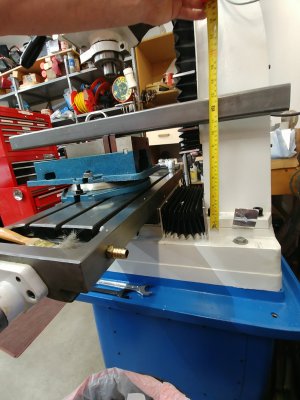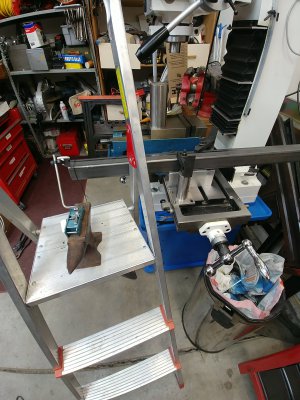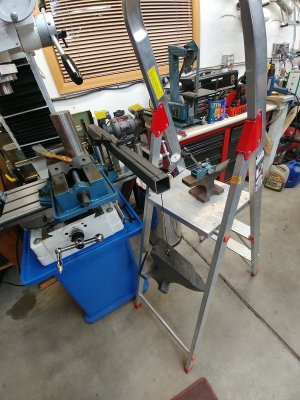I tell my young engineers the following:
Believable: WAG (Wild A$$ Guess) is less than INFORMED OPINION is less than ANALYSIS is less than TEST. Test is best.
Laziness: WAG (Wild A$$ Guess) is easier than INFORMED OPINION is easier than TEST which can be easier than ANALYSIS.
Thinking about this on the way home, I realized that this is an single variable problem is easier to test than analyze. So, I did a simple test.
The column and base stiffness is unchanged, so this is really a question of how stiff is a thick aluminum shim. And a simple cantilevered beam stiffness test, set at the appropriate moment arm and load should be a reasonable approximation to at least determine the magnitude of the problem (are we talking mils, tenths of mils or angstroms).
I took a 2" steel box beam and determined that the top of my vice is 11" above my column base. It's not unreasonable to machine above the vise, so, lets say 12" to make things easy. My test moment arm is 12"
What's a good machining load? Hell, I don't know, but I have a 55lb Chineseium Anvil that actually weighs 48lbs (too munch Bondo?). So, 48lbs sounds like a great side load due to machining and feeds.
I clamped the beam to my table with 12" cantilevered forward. Using my 15-0-15 gauge (.0005/division), I set an indicated deflection (.015" for the first test).
I then carefully suspended my anvil from the wire and recorded .003" deflection (a reduction in the indicated value).
I next clamped the beam in place on a ~1.25" steel plate (all I had on hand) and repeated the test. Same clamping and torque. I recorded .003-.0035". So, as expected no real change.
Lastly, I clamped the beam in place on a ~2.625" aluminum block (6061-T6) and repeated the test. Again, same clamping and torque. I recorded .0105" deflection.
I got an additional .0075" deflection by just adding the AL block! That's a 150% increase, and real numbers not angstroms.
Now, if I used an infinitely stiff bar and recorded zero deflection with the all steel set-up, I'd still expect to record the same .0075" from the additional AL shim since the shim was the only variable and it's the weak spring in the system.
The results are scalable, if my 48lbs is too high, 1/2 the load (24lbs) would produce 1/2 the deflection (.0038"). Too low and, well, you get the picture. Now, this is just a static load test. A dynamic loading due to the cutters would probably produce smaller numbers (maybe 40-60% of static), but still significant.
Please, can a more experience machinist comment on the loads, it's out of my wheel-house and I didn't have the time to research it.
In the end, my opinion is that using an Aluminum shim could produce real and noticeable errors due to deflections. I'd personally buy some steel for this purpose before using free aluminum. Again, just my opinion.
PS. Please feel free to mock my hokey, "stop it, you're scaring me" setup. But I only had a free hour before soccer drop off, and still managed to take 3 reading for each test configuration. This has been a fun exercise.

Quote from my son, when I asked him to get my anvil "You want WHAT!"
Regards,
Joe.




